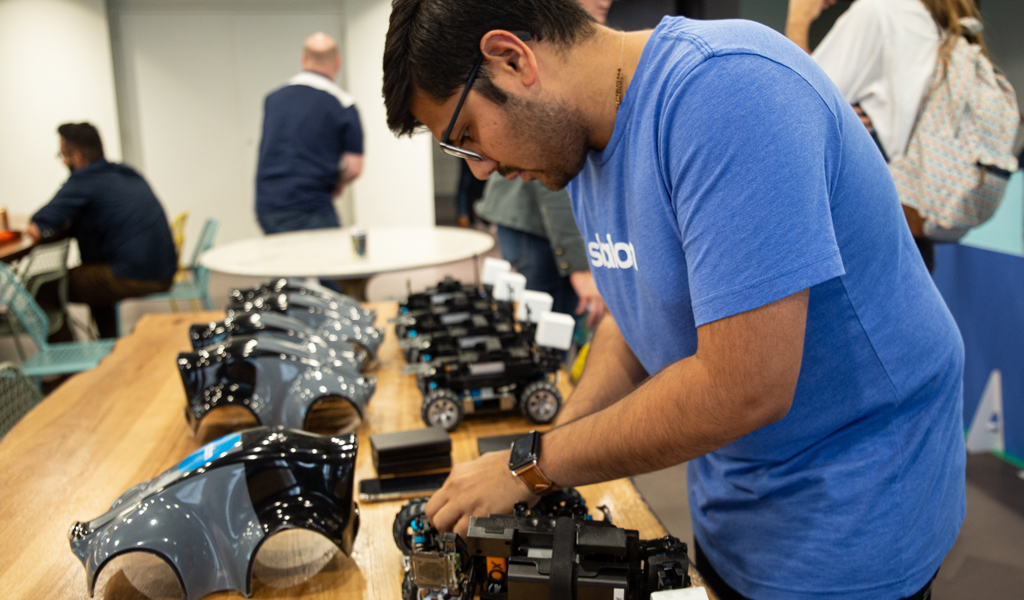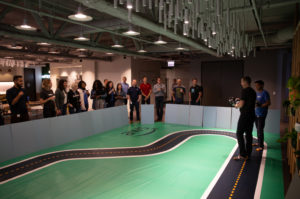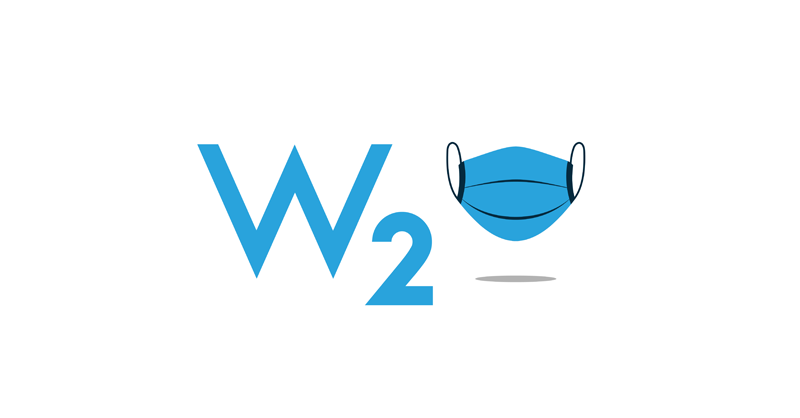
Learning Machines: A Look Inside Slalom’s Culture of Curiosity
It’s a Friday afternoon in September, and sunlight pours in through tall windows. We’re in a bright, modern office overlooking Millennium Park—with a racetrack in the kitchen.
A large group surrounds what looks like a miniature arena, but that is really a sprawling printed track adhered to the floor, bordered by foamboard barriers, and featuring a wide, looping path. When a small car sporting a Slalom-logoed-sticker zips around a tight S-curve, the crowd breaks into cheers.
“We did a test run of the track a few days ago,” explains Shrey Patel, a technologist and one of the event’s organizers. “Whenever we set up the track in a new place, there are dozens of variables to consider. Little things can disrupt the sensor on the car.”
Those factors matter because today the Slalom crew is demoing a product from Amazon Web Services (AWS) called AWS DeepRacer. The track is simple, though precisely measured printed vinyl—it’s the 1/18th scaled model cars that are truly unique.
 The cars are fully programmable, autonomous, and deploy a type of machine learning called reinforcement learning. First, models are trained in a simulated track hosted in the AWS cloud, then the cars use these models to adapt to changes on the track with each lap. Programmers from around the world compete to build the best model code and see whose model can learn to navigate the track the fastest.
The cars are fully programmable, autonomous, and deploy a type of machine learning called reinforcement learning. First, models are trained in a simulated track hosted in the AWS cloud, then the cars use these models to adapt to changes on the track with each lap. Programmers from around the world compete to build the best model code and see whose model can learn to navigate the track the fastest.
Pointing to the kitchen’s ceiling, Patel says, “See those overhead lights? We’ve had to change the track’s placement half a dozen times. The lights create reflections off the track, which our car reads as part of the path it needs to maneuver through.”
If having a racetrack in your office kitchen sounds unusual, well, it’s not at Slalom. Internal events like this track demo give Slalom consultants the chance to learn from each other and get familiar with expertise outside their own.
“We really encourage folks to get their hands into new things,” says Katie Morris, a Managing Director at Slalom Chicago. She joined today’s event to learn from the facilitators, too. “One thing that is unique about Slalom is that we have a wide breadth of capabilities. That means that we can create some cool collisions between our technologists, our people specialists, and our business strategists—and that makes things fun.”
“With DeepRacer, we all compete against each other, but also all learn together,” says Miheer Munjal, a technology lead and one of the event organizers. “It’s a great opportunity to get hands-on in a newer branch of machine learning in the real-world.”
It’s an opportunity for Slalom team members to become familiar not just with a new technology, but with a new approach to problem-solving that then they can integrate into a variety of projects.

“Sharing our knowledge as a team gives everyone another database, another language besides what they’re used to,” says Morris. “So, when we are with our clients, we can say, ‘Oh, I remember how Slalom used reinforcement learning on another project and we were able to do this. Does it apply to this situation?’ It gives our consultants a new set of data that they can apply.”
Back on the track, the Slalom team resets the car after a series of attempts at a particularly tricky turn. It heads strongly into the left bend, then shoots down the straightaway without so much as a wobble.
The room erupts in applause and cheers.
“We are in the early days of machine learning, specifically reinforcement learning,” Munjal says. “What the future is going to look like starts right here, right now.”




